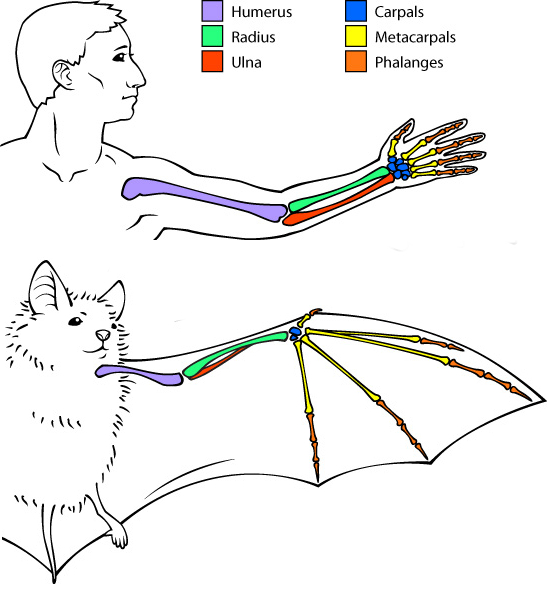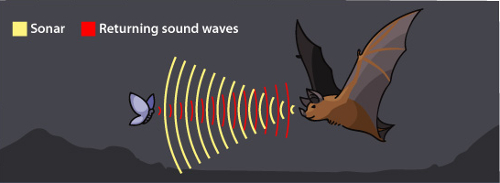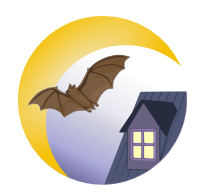Bats!
Bats belong to the taxonomic group Chiroptera. They are the only mammals with the ability to fly. Bats are misunderstood animals, and misconceptions often cause people to drive them away. However, bats are harmless animals that play a very important role in ecosystems. Around 70% of the world’s bats are insectivores, other species are important pollinators, while others are frugivorous and play an important role in seed dispersal.
Bats have an incredibly long lifespan considering their small size. Some species can live for more than 30 years, including the little brown bat which can live for up to 39 years!
Anatomy

Bats are mammals, and like all other species in this group, embryos develop inside females, and females nurse their babies with milk. When bats are born, they already have milk teeth and their permanent adult teeth emerge later on.
Like us, bats have lungs and a four-chamber heart. Contrary to popular belief, bats have good eyesight although they use echolocation to find food.
The scientific name for bats is chiroptera which means “hand wing”. Bats have the same bones in their wings as we have in our arms. The bones in their wings only differ from our arm bones in their size (fig. 1). Bats are endothermic organisms, meaning that they are able to use the heat generated by their bodily functions to maintain a high body temperature. Interestingly, bats are also able to drop their body temperature as low as 3ºC in hibernation. As a result, they are also considered to be heterothermic.
Bat wings are made up of a membrane called the patagium which stretches between the hand bones and hindlimbs. Another section of the patagium, called the uropatagium, extends between the hindlimbs and assists in flight and catching insects.
Bats’ ears are remarkable (Fig. 3). They are large in relation to the size of their head and eyes. The entrance of the ear is protected by a piece of cartilage known as the tragus (marked B, in Fig. 3). The shape, size and colour of the ear and the tragus are important features for identifying species (Fig. 3).
Bats can hang upside-down effortlessly, partly in thanks to a special tendon. The weight of the animal pulling on the tendon causes its claws to grip onto the surface. The bats’ circulatory system also possesses valves that prevent blood from accumulating in their head. These nocturnal animals therefore sleep wrapped in their wings in order to conserve their energy. To take flight, they need only to let themselves fall.
Echolocation
All bats in Canada, use a special locating system called echolocation to navigate. They emit very high-frequency sounds with their vocal cords. These high-frequency calls, transmitted through the mouth of most species (except Townsend's big-eared bat, that can transmit calls through its nose!), have a frequency between 8 and 120 kilohertz (kHz). Most of them are imperceptible to the human ear, which perceives frequencies in the range of about 2 to 20 kHz. In Canada, only spotted bats (~12 kHz) and hoary bats (~20 kHz) can emit calls under 20 kHz that humans can hear. The bat uses echolocation to navigate and hunt prey. It picks up information on the orientation, distance, size and even texture of insects.

The high-frequency calls encounter materials in the environment and rebound toward the bats who detects the echoes using their ears (fig. 4). The brain analyses the returning waves and allows the bats to acquire a mental image of the surrounding landscape. The nearer the object, the more quickly the waves return to the bat.
Each species has its characteristic call frequency. However, within the same species, the sounds emitted vary from one individual to another depending on the activity being performed, such as leaving the colony, or the different steps of feeding - search, detection, approach and attack on the prey. The calls also vary depending on the type of habitat and environment where the bats are. Biologists use recordings of these high-frequency calls, called sonograms, to identify the bat species.
Diet

All of Canada’s bats are insectivores. They locate their prey using echolocation and may hunt during two separate times in one night. The first hunting period begins shortly after dusk and can last until 5 hours after sunset. The second hunting period occurs later on in the night. Bats are the main predators of flying nocturnal insects. A single little brown bat is capable of eating the equivalent of its weight in insects, about 600 per hour, in just one night. They can capture flying as well as resting insects, and usually hunt above bodies of water, on treetops and near light sources that attract insects.
Therefore, bats not only play an important role in ecosystems, but they are also of significant importance to humans. For instance, some of the insects they feed on are deemed harmful to the agriculture and forestry sectors. It is easy to imagine the huge number of moths that have been eaten by bats during the great Eastern Spruce Budworm epidemics in Eastern Canada. Finally, having bats near your house or cabin is a natural and effective way to reduce the number of unwanted insects in your immediate surroundings without resorting to insecticides.
Body design and lifestyles
A number of aspects of the body design of bats have been used to make guesses about their lifestyles and habitat use. While the relationships are not perfect, we can make a number of reasonable guesses about a bat species based on its body size, wing design, and echolocation calls. It is best to think of these influences relative to each other rather than absolutely.
Bigger bats have to fly faster than small bats to stay in the air and they tend to be less manoeuvrable. This means that bigger bats are more likely to feed in areas with less clutter due to vegetation (e.g., forest edges and open spaces).
Wing size also influences where and how species of bats fly. Bats with wings with large surface areas relative to their body size allow them to fly slowly with more manoeuvrability. However, the cost of flight for these bats is relatively high (i.e., they get poor fuel economy). In contrast, bats with wings with small surface areas relative to their body size allow them to fly fast with less manoeuvrability, but with a relatively low cost of flight (i.e., they can travel farther distances using less energy).
Wing shape is also important. Bat species with relatively long and narrow wings tend to fly fast and straight. In contrast, short and wide wings allow a species to be highly manoeuvrable.
Finally, there is the influence of echolocation call structure. Higher frequency calls travel shorter distances, but are better for detecting smaller objects and prey. Conversely, lower frequency calls travel further but are only good for detecting larger objects and prey.
Taken together, larger bat species tend to have wings with smaller surfaces areas relative to their body size that are longer and more narrow, in combination with low frequency echolocation calls (e.g., Hoary bats). These bat species tend to fly in the open and feed on larger insects. They are also more likely to migrate over longer distances. At the other end of the spectrum, smaller bats tend to have wings with larger surface areas relative to their body size that are wider, in combination with higher frequency echolocation calls (e.g., California myotis). They tend to be more manoeuvrable and fly more slowly in cluttered areas catching small insects. They are also less likely to migrate long distances.
Migratory bats
Most of the long-distance migratory bats spend the winter further south, but return to Canada in the summer. Some silver-haired bats have also been seen to migrate in large numbers from Alberta to BC. It roosts alone or in small groups near the tops of trees, under tree bark, or in the holes made by woodpeckers. In more urban areas, it often shows up roosting under patio umbrellas.
During the summer, migratory bats primarily roost in trees, but can occasionally be found in buildings. So far, there have been no cases of white-nose syndrome recorded for this type of bat.
Non-migratory bats 
Non-migratory bats spend the winter hibernating in hibernacula, which are mainly abandoned mines,natural caves,and deep rock crevices. During the winter, these bats reduce their body temperature to around 2-5ºC to minimize their energy consumption given the lack of available food during this period.
Non-migratory bats in Eastern Canada are affected by a fungal disease called white-nose syndrome. This disease kills bats by causing them to arouse from hibernation too frequently, which uses up their energy stores before winter is finished.
The roles of bats in Canada’s ecosystems
- Bats are particularly important because they are the main predator of nocturnal insects (e.g. moths). Bats consume very large quantities of insects. On average, an individual consumes 600 insects an hour. A bat can eat the equivalent of its own weight in one night!
- Since the species in Canada are strictly insectivores, they help control insect populations. The ecological services provided by bats reduce damage to harvests by insect pests. In this way, they act as natural insecticides.
- By consuming flying insect pests, bats have been shown to reduce the amount of pest insect larva on corn crops and in turn increase crop yields. It is estimated that loss of bats due to white-nose syndrome in North America could lead to agricultural losses estimated at more than $3.7 billion/year.
- Their feces (guano) can be used as a natural fertilizer.

